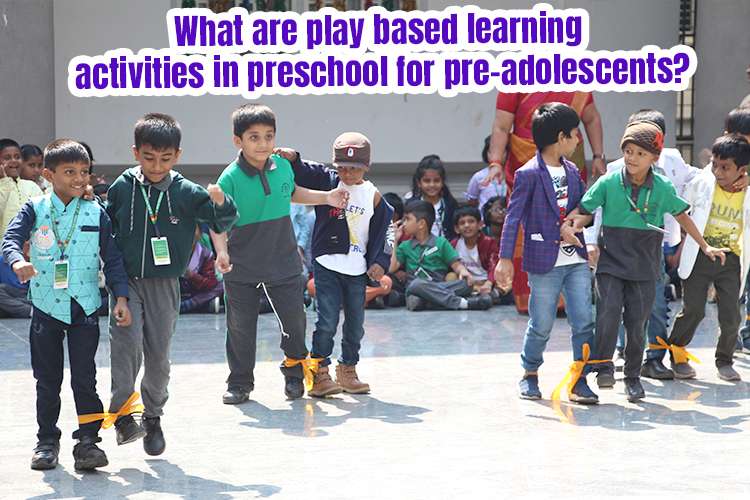Play-based learning activities in preschool for Pre-adolescents are immersive educational experiences that utilize play as a central component. These activities engage children in hands-on, interactive, and enjoyable tasks that promote their cognitive, social, emotional, and physical development. Through play, Pre-adolescents can explore, experiment, problem-solve, and collaborate, fostering a love for learning and a deeper understanding of various concepts. Play-based learning recognizes the natural inclination of children to learn through play and harnesses this innate curiosity to create meaningful and impactful educational experiences.
What is active learning?
Active learning is an educational approach that promotes student engagement and participation in the learning process. It involves students actively constructing their knowledge and understanding through hands-on activities, discussions, problem-solving, and critical thinking. This approach encourages deeper understanding amongst kids by showing higher retention of knowledge, and the development of important skills such as collaboration, communication, and independent thinking.
Implement play-based learning activities for 10 years older kids-
Exciting play-based learning activities for 10-year-old kids must be implemented in a stimulating environment that encourages their natural curiosity. Additional approaches to carrying out this implementation include those listed below:
1. Creating an enriched play environment –
To effectively implement play-based learning activities for 10-year-olds, it is crucial to create an enriched play environment. This entails providing a wide range of stimulating materials, such as building blocks, puzzles, art supplies, and pretend play props. These resources encourage children to engage in imaginative and exploratory play, fostering their creativity and problem-solving skills.
2. Incorporating games and challenges –
Games and challenges can be excellent tools for integrating learning into play. By incorporating educational elements into fun activities, children are more likely to be motivated and actively participate. For instance, a scavenger hunt can be designed to promote problem-solving and critical thinking while keeping the element of excitement alive.
3. Integrating technology in play –
In today’s digital age, technology plays a significant role in our lives. Integrating age-appropriate technological resources can enhance experiential learning experiences for kids. Educational apps, interactive websites, and educational videos can be utilized to introduce new concepts and support their learning journey.
Beneficial learning activities for Pre-adolescents-
Exciting learning activities for Pre-adolescents offer numerous benefits by sparking their motivation, engagement, and active participation, leading to enhanced learning outcomes and a positive attitude towards education. Benefits of conducting such educational activities are mentioned below:
1. Holistic development –
Learning activities cater to the holistic development of kids. Through play, children engage in various activities that stimulate their cognitive, social, emotional, and physical growth. They develop problem-solving skills, creativity, emotional intelligence, and social skills by interacting with their peers during play.
2. Motivation and engagement –
Play is inherently enjoyable for children. When learning is incorporated into play, it enhances motivation and engagement levels. By providing a fun and interactive environment, children are more likely to develop a positive attitude towards learning, which can have a lasting impact on their educational journey.
3. Individualized learning –
Experiential learning activities allow for individualized learning experiences. Each child has unique strengths, interests, and learning styles. By incorporating different types of play, educators can cater to diverse learning needs, ensuring that every 10-year-old is actively involved and challenged at an appropriate level.
When and where to implement experiential learning activities?
Experiential learning activities are used both inside and outside of the classroom, giving kids the chance to learn and explore in a variety of settings. Below mentioned are some of the ways where these techniques are implemented effectively:
1. Classroom setting –
hands-on learning activities can be effectively implemented within the classroom setting. Educators can designate specific areas for different types of play, such as a block corner, art station, or dramatic play area. By incorporating play into the curriculum, teachers can create a dynamic learning environment that promotes active engagement and exploration.
2. Outdoor spaces –
Nature provides a rich and stimulating environment for experiential learning. Outdoor spaces, such as playgrounds or gardens, offer opportunities for children to engage with their surroundings, develop gross motor skills, and explore the natural world. Outdoor play fosters a sense of wonder and curiosity, creating memorable learning experiences.
3. Community engagement –
hands-on learning activities can extend beyond the classroom and involve the local community. Field trips to museums, parks, or cultural events allow children to connect their learning with real-world experiences. Community engagement broadens their horizons, enhances their understanding of the world, and encourages social interaction with a diverse range of individuals.
Exciting learning based activities hold immense value in the education of kids in preschool settings. By implementing a range of stimulating play experiences, educators and parents can facilitate holistic development, foster motivation and engagement, and provide individualized learning opportunities.
Hands-on learning recognizes the innate curiosity and creativity of children, harnessing their natural inclination to learn through play. By embracing this approach, educators and parents can create a solid foundation for lifelong learning and a love for education. These learning activities empower children to develop problem-solving skills, creativity, and a positive attitude towards learning, laying a solid foundation for their educational journey and beyond. Learning activities also allow children to explore, discover, and learn in an enjoyable and meaningful way. So, let’s embrace the power of play and create a solid foundation for lifelong learning.




